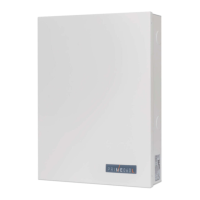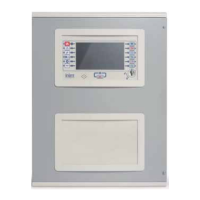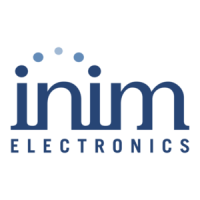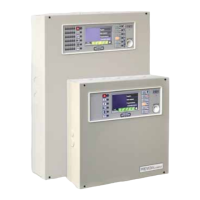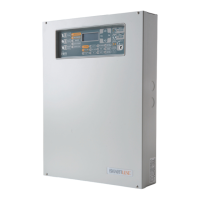Do you have a question about the INIM Electronics Prime060S and is the answer not in the manual?
Details the 24-month warranty for INIM Electronics products against defects, covering repair or replacement.
Confirms compliance with Directive 2014/53/UE for listed devices, allowing unrestricted use in EU countries.
Provides instructions for environmentally responsible disposal of electrical and electronic equipment.
Explains the manual's purpose, scope, and intended audience for system installation and operation.
Defines essential terms like 'Qualified Personnel', 'Control Panel', 'System', 'Select', and 'Press' for clarity.
Explains the meaning of 'Note', 'Attention!', and 'Danger!' symbols to ensure safe and correct procedure execution.
Provides manufacturer contact information and details on the Prime control panel series, models, and applied standards.
Highlights patented features of the Prime series, including Input/Output Terminals, nBy/X reader, and Learn zone balancing.
Lists and describes the purpose of various manuals provided for the Prime system, including installation, programming, and user guides.
Defines the qualifications and responsibilities of installers and users, including access codes and system usage.
Explains the four distinct levels of access (1-4) to the control panel, detailing the permissions associated with each level.
Lists all items included in the Prime control panel package and provides an overview of the control panel's physical description.
Details the technical specifications, including voltage, current, dimensions, and security grade, for different Prime control panel models.
Illustrates and describes the various internal parts of the Prime control panel, referencing labels for easy identification.
Provides a table detailing the function and location of each labeled component on the Prime control panel's enclosure.
Details the specific components and connectors found on the control panel's motherboard, crucial for understanding system connections.
Explains the meaning of the Green, Blue, and Yellow LEDs on the motherboard, aiding in troubleshooting and status monitoring.
Lists the functions of various terminals on the motherboard, categorized by their identifier and purpose, for wiring and connection.
Explains ATS categories, parameters, and their relation to SPT configurations and network interfaces for alarm transmission.
Covers the I-BUS interconnection system for peripherals and the functionality of the events log memory for data retention.
Specifies the required environmental conditions (temperature, humidity) for control panels and peripherals to operate correctly.
Lists the various peripheral devices that can be connected to the Prime system via the I-BUS for expanded functionality.
Describes the optional SmartLogos30M board, enabling voice mailbox, dialer, and answerphone functions for enhanced communication.
Provides detailed steps for securely mounting the control panel enclosure to a wall, including hole preparation and fixing.
Guides on safely connecting the control panel to mains power, emphasizing circuit breaker use, earthing, and electrical safety precautions.
Details the procedure for connecting the backup battery, including polarity, battery types, and safety requirements.
Explains how to connect the thermal probe to the power supply for battery temperature compensation and protection.
Outlines the steps for opening the control panel, entering installer mode, and closing it securely to prevent tamper events.
Guides on connecting the control panel to a PSTN line for communication, including options for GSM integration.
Describes various methods for connecting to the control panel via PC, including USB, LAN, WiFi, and Inim Cloud services.
Provides instructions for installing the optional SmartLogos30M voice memory board into the control panel.
Explains how to activate and exit maintenance mode, its system effects, and how it's indicated on keypads.
Details the process of connecting various system peripherals to the control panel via the I-BUS connection.
Guides on selecting appropriate cables and positioning isolators for optimal I-BUS performance and signal integrity.
Explains the necessity of assigning distinct addresses to peripherals and how to use DIP-switches and LEDs for this purpose.
Describes a quick method for addressing keypads and readers during initial setup using the maintenance jumper.
Covers different ways to enroll peripherals, including automatic methods and manual configuration via software or keypad.
Details how to set protection levels for detectors using balancing resistors (N.O., N.C., Single, Double) for enhanced security.
Explains the resistance values for Normally Closed (N.C.) and Normally Open (N.O.) detector balancing states.
Describes single, double, and double-zone balancing techniques for detecting multiple conditions from detectors using resistors.
Explains double zone balancing with an EOL resistor for detecting 6 distinct conditions, including tamper.
Compares protection levels for roller blind/shock sensors using N.C. and N.C. with EOL balancing methods.
Details the N.C. balancing for sensors where alarms are detected by pulse count, not tamper events.
Explains single balancing for N.C. sensors with EOL, allowing detection of 4 conditions including tamper.
Describes the 'Learn zone balancing' feature for automatic setting of zone balancing values.
Guides on connecting outputs like sounders/flashers and open-collector outputs for event signaling.
Emphasizes critical wiring and safety precautions before applying power to the control panel and its peripherals.
Provides a detailed procedure for the initial power-up, including jumper settings and peripheral enrollment.
Details the process of addressing peripherals and initiating automatic enrollment for zone balancing during initial setup.
Guides on preparing for a zone test by setting partitions to stand-by and programming a zone as 'Delayed'.
Details how to configure voice signalling and perform an 'Away Arming' operation for system testing.
Explains how to violate a 'Delayed' zone and verify alarm signalling, entry time, and keypad feedback.
Describes the system's visual, audible, and voice call responses to alarms after a zone violation.
Provides instructions on how to disarm the system and stop active alarms using keypad shortcuts or scenarios.
Explains the procedure for clearing stored alarm event memories from the control panel.
| Model | Prime060S |
|---|---|
| Type | Control Panel |
| Zones | 60 |
| Partitions | 8 |
| Keypads | Up to 10 |
| Users | 100 |
| Siren Outputs | 2 |
| Protection Degree | IP30 |
| Communication | GSM, PSTN |
| Programmable Outputs | 6 |
| Battery Backup | 7Ah |
| Humidity | 93% non-condensing |
| Certifications | EN 50131-1, EN 50131-3 |
| Event Memory | 2000 events |
